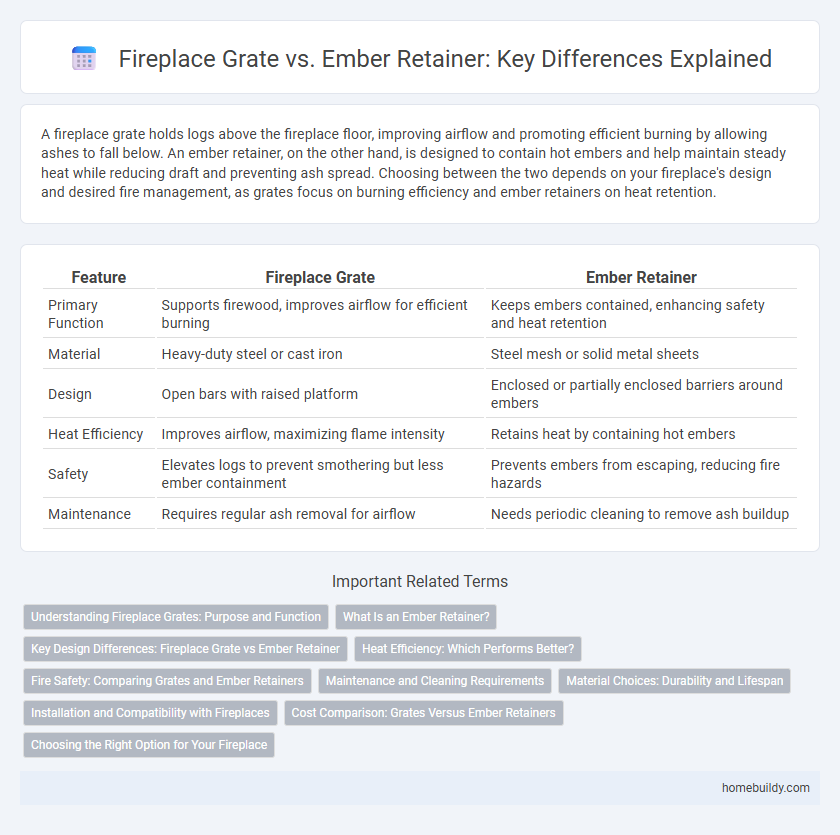A fireplace grate holds logs above the fireplace floor, improving airflow and promoting efficient burning by allowing ashes to fall below. An ember retainer, on the other hand, is designed to contain hot embers and help maintain steady heat while reducing draft and preventing ash spread. Choosing between the two depends on your fireplace's design and desired fire management, as grates focus on burning efficiency and ember retainers on heat retention.
Table of Comparison
| Feature | Fireplace Grate | Ember Retainer |
|---|---|---|
| Primary Function | Supports firewood, improves airflow for efficient burning | Keeps embers contained, enhancing safety and heat retention |
| Material | Heavy-duty steel or cast iron | Steel mesh or solid metal sheets |
| Design | Open bars with raised platform | Enclosed or partially enclosed barriers around embers |
| Heat Efficiency | Improves airflow, maximizing flame intensity | Retains heat by containing hot embers |
| Safety | Elevates logs to prevent smothering but less ember containment | Prevents embers from escaping, reducing fire hazards |
| Maintenance | Requires regular ash removal for airflow | Needs periodic cleaning to remove ash buildup |
Understanding Fireplace Grates: Purpose and Function
Fireplace grates elevate firewood to improve airflow, promoting efficient combustion and reducing smoke inside the fireplace. They provide a stable base to contain logs while allowing ash and embers to fall through, facilitating easier cleanup. Unlike ember retainers, which focus on trapping hot embers for sustained heat, grates prioritize proper wood placement and optimal burning conditions.
What Is an Ember Retainer?
An ember retainer is a sturdy, heavy-duty metal accessory designed to hold burning embers securely within a fireplace, enhancing airflow and promoting efficient combustion. Unlike a fireplace grate, which primarily supports logs for burning, an ember retainer maintains a concentrated bed of hot embers, helping to sustain heat and prevent ash from scattering. This tool is essential for optimizing fire performance and prolonging ember life in wood-burning fireplaces.
Key Design Differences: Fireplace Grate vs Ember Retainer
Fireplace grates are designed with raised bars to elevate logs, promoting air circulation for efficient combustion and easier ash cleanup. Ember retainers feature a more enclosed, basket-like structure that contains embers and prevents them from scattering, enhancing safety. Key design differences include the open framework of fireplace grates versus the compact, ember-holding design of ember retainers, each optimizing fire management in distinct ways.
Heat Efficiency: Which Performs Better?
Fireplace grates typically enhance heat efficiency by allowing better airflow beneath the fire, promoting complete combustion and higher heat output. Ember retainers, designed to hold embers in place, help maintain consistent heat for longer durations but may restrict airflow, potentially reducing overall heat efficiency. For optimal heat performance, fireplace grates generally outperform ember retainers by balancing airflow and ember retention effectively.
Fire Safety: Comparing Grates and Ember Retainers
Fireplace grates elevate wood to improve airflow and combustion while containing logs securely, reducing the risk of falling embers outside the fireplace. Ember retainers specifically focus on containing hot embers within the fireplace, minimizing sparks and embers that can ignite nearby combustible materials, enhancing overall fire safety. Choosing between a fireplace grate and an ember retainer depends on the primary safety concern: improved burning efficiency versus ember containment.
Maintenance and Cleaning Requirements
Fireplace grates require regular removal of ashes and debris to maintain airflow and efficient burning, with periodic inspection for rust or warping to ensure durability. Ember retainers focus on containing embers, demanding less frequent cleaning but necessitating careful ash removal to prevent buildup that could reduce containment effectiveness. Both tools benefit from routine brushing and occasional washing to prolong lifespan and maintain optimal fireplace performance.
Material Choices: Durability and Lifespan
Fireplace grates are typically made from heavy-duty steel or cast iron, offering superior durability and the ability to withstand high temperatures over extended periods. Ember retainers often use lighter gauge metal or stainless steel, providing corrosion resistance but sometimes sacrificing long-term strength under intense heat. Choosing cast iron grates ensures a longer lifespan due to excellent heat retention and resistance to warping compared to thinner materials used in many ember retainers.
Installation and Compatibility with Fireplaces
Fireplace grates are designed for easy installation, typically fitting most standard fireplace sizes without modification, ensuring proper airflow for burning logs. Ember retainers require a more precise fit and may need adjustment or specific dimensions to be compatible with certain fireplace models, particularly those designed to contain sparks and embers. Both components serve different purposes, so selecting the right one depends on the fireplace design and the user's need for either efficient log placement or ember containment.
Cost Comparison: Grates Versus Ember Retainers
Fireplace grates generally cost between $30 and $100 depending on material and size, offering durable steel construction that supports larger logs for efficient burning. Ember retainers are typically less expensive, ranging from $15 to $50, designed to hold smaller embers and improve airflow with minimal material usage. Choosing between the two depends on budget priorities and the need for either robust log support or enhanced ember containment.
Choosing the Right Option for Your Fireplace
A fireplace grate is designed to elevate firewood, improving airflow and combustion for a cleaner, hotter fire, while an ember retainer focuses on containing glowing embers to maintain consistent heat and protect the fireplace floor. Choosing between a fireplace grate and an ember retainer depends on the type of fuel used, desired heat distribution, and maintenance preferences. For wood-burning fireplaces aiming for efficient burning and easy ash cleanup, a grate is ideal; ember retainers suit homeowners prioritizing ember containment and prolonged radiant heat.
Fireplace grate vs Ember retainer Infographic

 homebuildy.com
homebuildy.com